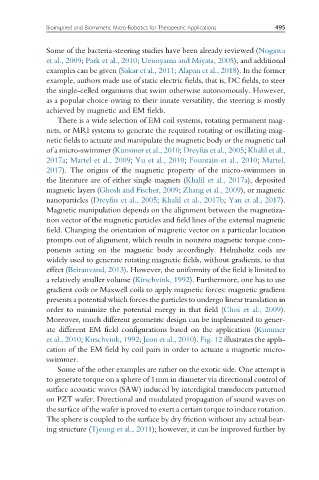Page 501 - Handbook of Biomechatronics
P. 501
Bioinspired and Biomimetic Micro-Robotics for Therapeutic Applications 495
Some of the bacteria-steering studies have been already reviewed (Nogawa
et al., 2009; Park et al., 2010; Uenoyama and Miyata, 2005), and additional
examples can be given (Sakar et al., 2011; Alapan et al., 2018). In the former
example, authors made use of static electric fields, that is, DC fields, to steer
the single-celled organisms that swim otherwise autonomously. However,
as a popular choice owing to their innate versatility, the steering is mostly
achieved by magnetic and EM fields.
There is a wide selection of EM coil systems, rotating permanent mag-
nets, or MRI systems to generate the required rotating or oscillating mag-
netic fields to actuate and manipulate the magnetic body or the magnetic tail
of a micro-swimmer (Kummer et al., 2010; Dreyfus et al., 2005; Khalil et al.,
2017a; Martel et al., 2009; Yu et al., 2010; Fountain et al., 2010; Martel,
2017). The origins of the magnetic property of the micro-swimmers in
the literature are of either single magnets (Khalil et al., 2017a), deposited
magnetic layers (Ghosh and Fischer, 2009; Zhang et al., 2009), or magnetic
nanoparticles (Dreyfus et al., 2005; Khalil et al., 2017b; Yan et al., 2017).
Magnetic manipulation depends on the alignment between the magnetiza-
tion vector of the magnetic particles and field lines of the external magnetic
field. Changing the orientation of magnetic vector on a particular location
prompts out of alignment, which results in nonzero magnetic torque com-
ponents acting on the magnetic body accordingly. Helmholtz coils are
widely used to generate rotating magnetic fields, without gradients, to that
effect (Beiranvand, 2013). However, the uniformity of the field is limited to
a relatively smaller volume (Kirschvink, 1992). Furthermore, one has to use
gradient coils or Maxwell coils to apply magnetic forces: magnetic gradient
presents a potential which forces the particles to undergo linear translation in
order to minimize the potential energy in that field (Choi et al., 2009).
Moreover, much different geometric design can be implemented to gener-
ate different EM field configurations based on the application (Kummer
et al., 2010; Kirschvink, 1992; Jeon et al., 2010). Fig. 12 illustrates the appli-
cation of the EM field by coil pairs in order to actuate a magnetic micro-
swimmer.
Some of the other examples are rather on the exotic side. One attempt is
to generate torque on a sphere of 1mm in diameter via directional control of
surface acoustic waves (SAW) induced by interdigital transducers patterned
on PZT wafer. Directional and modulated propagation of sound waves on
the surface of the wafer is proved to exert a certain torque to induce rotation.
The sphere is coupled to the surface by dry friction without any actual bear-
ing structure (Tjeung et al., 2011); however, it can be improved further by

